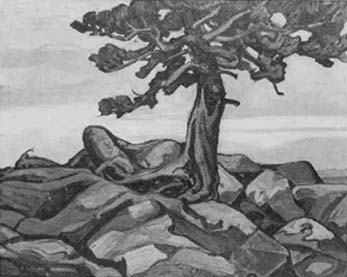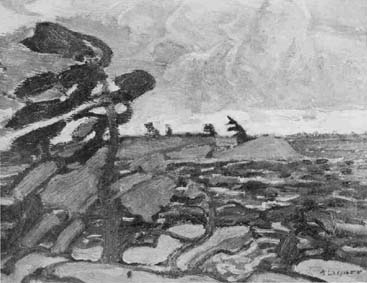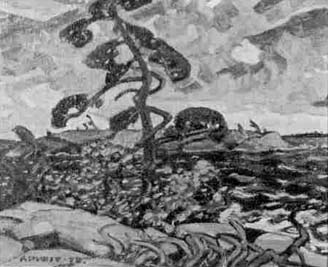
Bulletin 9-10 (V:1-2), 1967
Home
Français
Introduction
History
Annual Index
Author &
Subject
Credits
Contact



Georgian
Bay and the Development
of the September Gale Theme in
Arthur Lismer's Painting, 1912-21
by Barry Lord, Associate Fellow, Dept. of Communications Conestoga
College, Kitchener
Pages 1
| 2 | 3 | 4
| 5 | 6
It is uncertain whether the 1921 canvas Pine Tree and Rocks (plate
10), now in the London Public Library and Art Museum, preceded or
followed September Gale; it is definitely related, and can
best be understood as a parallel study. The dominance of the tree
with its trunk and limbs cropped by the framing edge, and the rugged
but comparatively peaceful mood suggest the importance of the
Thornhill paintings of 1916-17 to the artist's development of his
theme. It is as if he had isolated his subject in the serenity of
the Thornhill works, introduced it to its northern environment in
this painting, and finally in September Gale (plate 1) was
able to give it the vigour and expressive character he had
discovered in A Westerly Gale, Georgian Bay (plate 7). In Pine
Tree and Rocks (plate 10) the rock formations are no longer
simply a supportive ground for foreground detail but for the first
time play a real structural role in the picture. Both impasto and
the hitherto common fauve-like dabs of colour are abandoned
here, and a rich fully-brushed style with bold dark outlines and
contour shading is found to have considerable expressive potential.
The significance of the direction of the brush-stroke in lending
dynamics to the colour and light energy of the subject is partly
explored, in some areas with quite thin pigment. Because of the
importance of the rocks, the viewpoint is as steeply up as it
usually is down, and the horizon is rather conventionally indicated at far right with a strong blue. The sky is neglected because
of the artist's preoccupation with tree and rocks, and the brown
root in the lower-right foreground is a trite attention-getting
device; but withal we sense that important strides have been taken,
and we are ready to turn to the three paintings of the
"September Gale" group.
In the Sketch for September Gale (plate 11), (38) now in the
collection of Dr John L. Parnell of Vancouver, Lismer states with
real brilliance the striking light and dramatic movement which at
tract him to the subject. This strong right-to-left movement leaves
the left third of his panel in some confusion. The lack of a strong
vertical thrust, present in the final version in the tree breaking
the top of the picture plane, allows the movement toward the left
to control the picture exclusively, at the expense of the grandeur
or monumentality which the painter intends. This fact and Lismer's
use of taches of colour and some impasto in the waves
indicate that the sketch was completed in 1920, before Pine Tree
and Rocks (plate 10). The bold outline and contour brush-stroke
are used in a rather rudimentary fashion for the rocks, in
foreground and middle ground, and the silhouette horizon of trees in
the wind is brought to the peak of its development. Cloud and
foreground tree forms have yet to be given the original treatment
explored in the rocks, and the shrubs in centre and lower right are
ineffectual attempts to organize the space of that area. Another
problem is the resolution of viewpoint, which is summarily indicated
rather than stated here. But the subject matter, nascent since his
experience of September 1913 is at last fully grasped with most of
its details.
The penultimate work in the series is the Study for September
Gale (plate 12), a 20 by 24 inch canvas in the collection of the
Right Hon. Vincent Massey at Batterwood House in Canton, Ontario.
Dated 1920, it is frankly a study and was not intended as an
independent completed work. The left third of the subject is
considerably clarified in this painting; the artist recognizes the
need to articulate clearly foreground, middle and distance there in
order to lend the desired monumental character to the central tree.
Space is found for the two subsidiary tree forms to the left,
although they remain quite flabby and inconclusive; it is as if
Lismer is content to note them down, anticipating that he will be
able to give them dramatic tension in the final version. Another
important addition is the growth of reeds, lower right; their
sinuous forms and the curve of the prominent elbow on the central
tree, recalling the 1917 Thornhill painting Spring-time on the
Farm (plate 8), perhaps suggest the lingering art nouveau influence,
which the artist would be more likely to introduce in a studio
canvas of this kind than in an in situ panel sketch. The
reeds
here remain embedded in the rocks and are accordingly less effective
than in the final version; only in the larger painting will Lismer
reconcile them with the swirling inlet of the bay, lower right, so
that the force of that section of the painting is integrated with
the rest of the work.
Another obvious gain in this study is the fact that the tree breaks
the picture plane at the top of the canvas, the sources for which we
have already noticed. But because we seem to see much more of the
tree, and because its cropping is obscured by a single mass of
foliage at the edge, the vertical thrust is far less telling than in
the final version. The horizontal mass of the island in middle
ground is retained as a compositional balance for this verticality,
while the small shrub to the right of the central tree remains
hardly developed from the Parnell sketch, not yet participating in
the movement of the wind, nor introduced across the vertical
movement as in the final painting. The rocks retain here a prominent
role right across the foreground, so that the picture is closer in
spirit to the earlier simple composition of horizontal layers in
perspective than is either the panel sketch or the finished canvas.
The result is a somewhat static and less exciting viewpoint, more
balanced and without the steep pitch of many of the works we have
been examining. The banal compositional containing device of the
root, lower right, developed from a shrub in the Parnell sketch and
a similar element in Pine Tree and Rocks (plate 10), is
another limiting factor which is discarded in the larger version.
The other limit to the view on the right, the distant horizon, is
here made more precise, and will be transposed directly into September
Gale itself (plate 1).
Probably the most important discovery in this study is the rendering
of the cloud forms as structural components of the volumetric unity
of the painting, rather than mere ciphers for the play of light or
opportunities for swirls of impasto. The contour shading of the
cloud masses and Lismer's characteristic use of arbitrary blues,
both of which appeared as early as 1913 in York Mills (plate
3), are here re-introduced to good advantage. His interest in
light is allowed in this canvas to play a role subordinate to that
of plastic structure. The fully-brushed sky and its active contour
forms contrast with the lightly painted rocks and with the bay,
which is treated with impasto to the right of the central tree and
with taches to the left. Apparently the artist, having
established the dynamics of movement and the vigour of the rocks in
the panel sketch, turns in this study to develop the sky as an area
of independent forms. In the final canvas his task is to
unify these disparate elements, particularly in the crucial area of
the bay.
Next Page | A
September Gale
1
| 2 | 3 | 4
| 5 | 6
Annual Index | Author & Subject | Credits | Contact
This digital collection
was produced under contract to Canada's Digital Collections program,
Industry Canada.
"Digital
Collections Program, Copyright
© National Gallery of
Canada 2001"